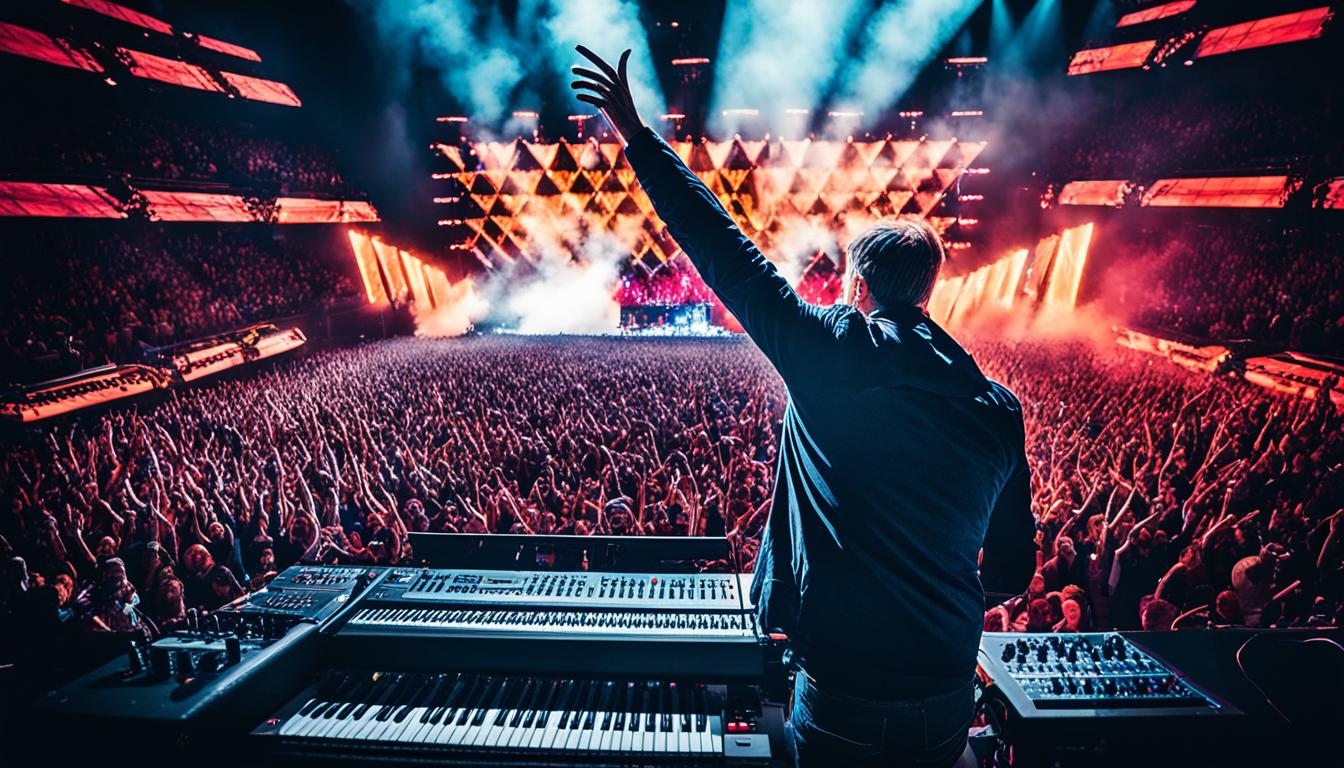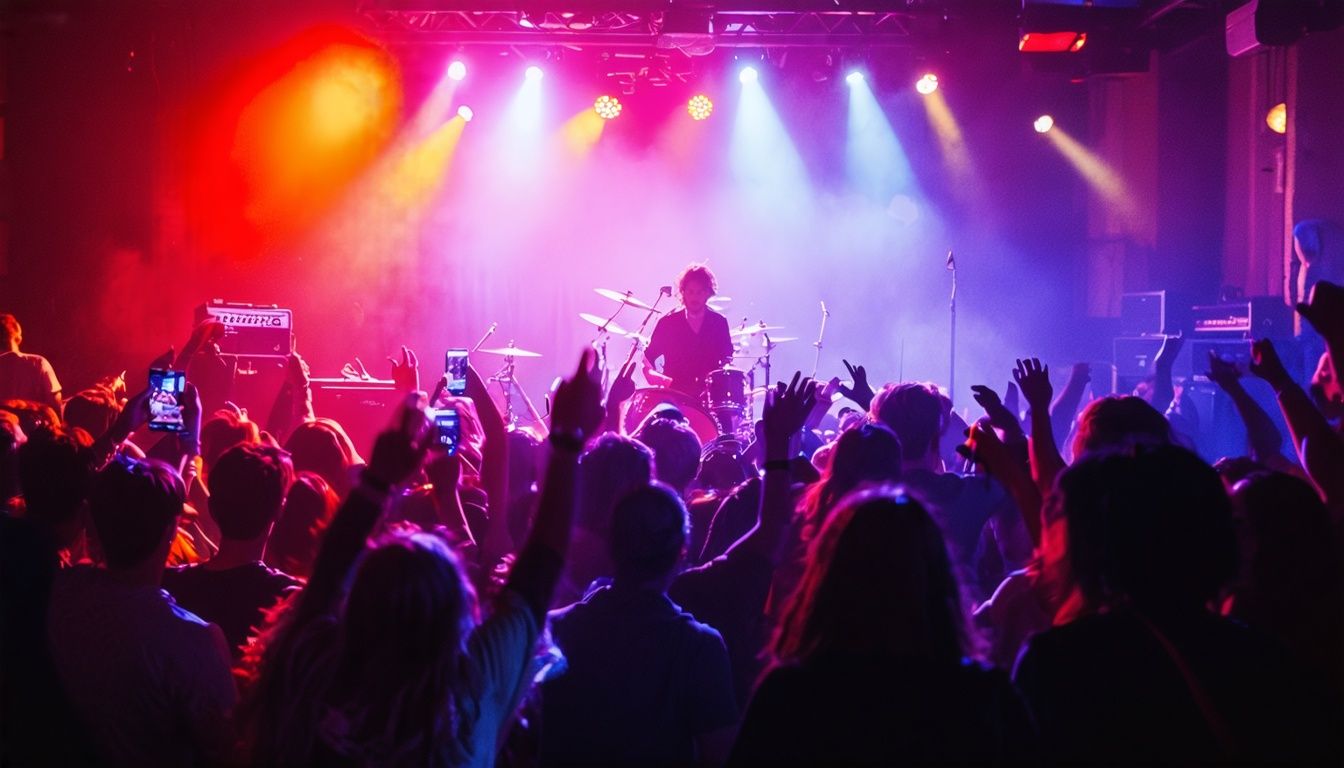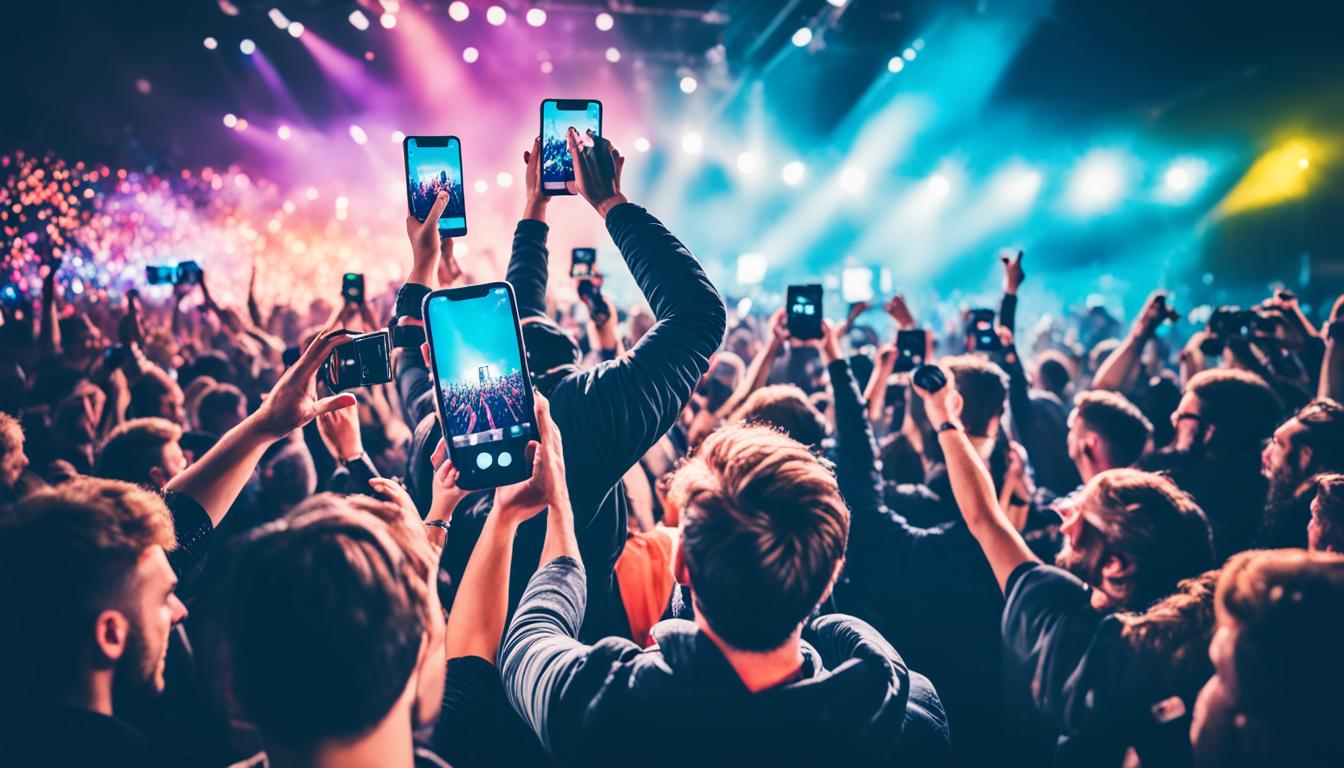As photographers, we’re always on the hunt to make our photos come alive. This is especially true for live music events. Concert photography editing isn’t just about fixing the images. It’s about boosting them to show the full intensity and passion of every performance. We’re here to show you how to make your shots echo with the energy they were taken in.
Getting the perfect shot in photography often involves more than just taking pictures. When we explore visual enhancement for concert images, we see how important editing is. It can majorly improve your concert photos. Discover with us how small changes can turn a simple photo into a treasure trove of memories.
Key Takeaways
- Unlock the potential of your concert photos through sophisticated editing techniques.
- Discover how the right tweaks in post-processing can enhance the emotional impact of live music images.
- Learn the importance of shooting in RAW to fully optimize your images during post-production.
- Understand that strategic adjustments in exposure and color can reinvent the visual narrative of your concert imagery.
- Explore tools that can help highlight the vibrant energy of live performances in your photography.
Understanding the Essentials of Concert Photography Editing
Enhancing live music photos starts with the camera snap. It catches the live show’s spirit. Improving pictures is more than fixing them after. It means planning ahead when taking them. We’ll look at camera setups and framing to help visual enhancement for concert images.
For concert photographers, shooting in RAW is key. It lets us tweak settings in ways that greatly improve image quality. Using manual controls like aperture, shutter speed, and ISO, we plan how to edit later.
Using spot metering helps us capture artists perfectly, despite tricky stage lights. This method is a big part of our editing skills. It makes sure the spotlight hits just right in the end.
Having the right gear matters too. Lenses that stabilize images are vital. They keep our photos sharp, even with accidental shakes. This gives us a strong start for visual enhancement for concert images.
- Capturing in RAW format for flexible post-processing
- Using spot metering to manage complex concert lighting
- Employing lenses with image stabilization to enhance sharpness
- Focusing on composition to tell a compelling story
We understand that navigating through complex editing techniques is akin to finding our way backstage—it’s about knowing the right moves to enhance every shot until it sings.
Paying close attention to how we frame our shots is important. Tools like the crop tool are crucial for a well-balanced look. When done right, these fundamentals make each photo feel alive. They let us share the intensity of live shows. By using these techniques, we bring our audience closer. They get to experience enhanced live music photos full of life.
Post-Processing Concert Images for Maximum Impact
As avid photographers, we know that not every shot captures the live event’s energy. To truly post-process concert images for maximum impact, it starts with picking the right photos. We choose images that tell the story of the night, not just technically good ones.
Selecting Images That Tell a Story
In searching for enhance live music photos, we carefully go through our shots. We look for moments where the artist’s energy, the bright lights, and the crowd’s passion all come together. These images then get a makeover in post-production to highlight their stories.
The Power of RAW Format in Concert Photography
The RAW format is essential for improving our concert photos. The detail in these uncompressed files gives us freedom to edit exposure, white balance, and contrast. This way, we keep the photo quality high, making sure no detail is missed.
Adjusting Exposure and Contrast for Dramatic Effect
Adjusting exposure and contrast brings life to our concert photos. Using Basic and Tone Curve panels, we add drama to the images. The play between shadows and highlights creates depth. This editing step is crucial for achieving the impactful look we aim for.
Advanced Techniques for Enhancing Live Music Photos
We aim to enhance live music photos in both taking and editing them. The editing phase has many advanced photo editing techniques. These can change good pictures into great ones. To make concert photos better, we often need small changes and careful adjustments.
Selective color processing is a key method we use. It helps highlight the most exciting parts of a concert picture. For example, the bright red of a guitarist’s shirt can stand out against a black-and-white background. This makes the viewer focus on the performer’s energy.
Lens correction is another advanced method. Even the best lenses might cause small errors in photos. But when we edit, we can fix these mistakes. This makes the pictures sharper and more true to what we actually saw.
Let’s talk about how we quickly edit using presets:
| Preset Type | Use Case | Customization Level |
|---|---|---|
| Black & White | Focusing on contrast and texture | High (adjust shadows and highlights) |
| Color Boost | Emphasize stage lighting and atmosphere | Medium (saturate selected colors) |
| Vintage Look | Capturing a retro or nostalgic mood | Medium (tone curves and color grading) |
| Sharpness & Clarity | Enhancing details of the artist and crowd | Low (slight tweaks as a finishing touch) |
We value the personal and artistic approach in editing photos. Advanced techniques are tools in our kit. It’s about how we use them. This way, our pictures tell the concert’s story in a unique way.
The Role of High ISO in Attaining Optimal Concert Pictures
As photographers, we face challenges with low light at concerts. We often use high ISO settings. This helps us capture sharp concert photos despite the low light. But, high ISO also means more digital noise in pictures.

Understanding our cameras is key to improve image quality. Each camera has its own ISO capabilities. By practicing, we learn the best ISO setting. It balances noise and image sharpness well.
Here’s how ISO levels affect concert photos:
| Camera Setting | Low Light Capture | Image Quality | Noise Level |
|---|---|---|---|
| Low ISO (100-400) | Poor – underexposed images | High – less digital noise | Low – clean look |
| Medium ISO (400-1600) | Good – balanced exposure | Good – acceptable noise | Moderate – some graininess |
| High ISO (3200+) | Excellent – fast shutter speeds | Varies – noise can degrade clarity | High – noticeable noise and grain |
We also use editing software after taking pictures. Modern software helps reduce noise. For too much noise, turning photos black and white can help. It makes the noise look intentional, adding a raw feel to the concert image.
The use of high ISO is vital for us to capture sharp concert photos. It lets us show the energy of live shows. Imperfections become part of the photo’s charm, enhancing the image quality.
Professional Image Editing Services vs. DIY Post-Processing
In the concert photography world, we often debate between hiring professionals or editing photos ourselves. This choice depends on the project’s complexity, our editing skills, and what we want in the end.
When to Seek Professional Assistance
Sometimes, we need a pro’s touch or specific expertise. If we’re good at photography but not at retouching, hiring a professional makes sense. This ensures our photos look their best and we might learn a few things about high-quality editing.
Tools and Software for DIY Post-Processing
For DIY fans, modern technology offers great tools for photo editing. Adobe Photoshop and Lightroom, for example, are perfect for photographers at any level. They help with simple adjustments or more complex edits, allowing us to achieve professional results ourselves.
| Aspect | Professional Services | DIY Post-Processing |
|---|---|---|
| Expertise Required | Handled by professionals | Requires personal proficiency |
| Time Investment | Minimal; dependent on service | Significant; dependent on project size |
| Cost Implications | Higher upfront costs | Potentially free or low cost based on software used |
| Customization Level | Depends on professional’s flexibility | Complete creative control |
| Learning Curve | Not applicable | Varies, from basic to advanced features |
The choice between professional editing or DIY should match our goals and availability. Either option has its benefits. By understanding our needs and limits, we choose the best way to tell our stories with authenticity and power.
Optimizing Dynamic Range and Color in Concert Images
Our main goal in optimizing concert pictures is to catch every tiny detail of the live event. We work hard to boost live music photos. We do this by carefully fixing the bright spots, dark spots, and everything in between. This makes the picture look deeper and more detailed. It’s like being at the concert, feeling the music’s beat.
In concert photography editing, adjusting the white balance is key. It helps set the photo’s mood. Small changes can make a jazz singer look warm or a rock concert feel cool and electric. We also fix colors to make every photo look bright and real.

Getting the dynamic range just right is a big deal for us. We make sure no details are lost in the bright or dark spots. This keeps the live concert’s mood and atmosphere. By doing this well, we make viewers feel like they’re back at the event.
Our detailed work in editing does more than just make live music photos better. It captures the concert’s full energy in every picture. Next time you look at concert photos, think about the careful editing. It makes each photo a true piece of art.
Using Image Stabilization and Manual Focus Techniques in Post
Post-processing is key for sharp concert photos. The scene is dark, the crowd is lively, and artists move quickly. These conditions make it hard to keep images sharp and focused. But, we can fix this by using image stabilization and manual focus techniques during editing. This helps make our photos as vivid and clear as the actual performance.
Improving Sharpness Post-Shoot
Image stabilization really helps in low-light concerts. It cuts down blur caused by moving performers, even when tripods can’t be used. But sometimes sharpness is still an issue. That’s when we imitate image stabilization in editing. By sharpening and applying filters, we mimic in-camera stabilization. This gives us the detailed photos we aim for in concert photography.
Manual Focus Correction in Editing
Autofocus might fail with fast action and changing lights at concerts. That’s when manual focus adjustments during editing are useful. We can zoom in and gently sharpen to fix the focus. This ensures the main parts of our photos are sharp. Things like a solo performance or a powerful facial expression stand out. By doing this, we can fix photos that weren’t perfect right off the camera.
In sum, these editing tricks let us keep the spirit of live shows in our photos. With image stabilization and manual focus, we capture sharp images. They bring the live concert’s energy right into the picture.
Conclusion
In our article, we’ve shown how to make live music photos better. It’s clear that enhancing photos after they’re taken is key. This turns a good photo into an unforgettable one. It starts with how well you capture the shot. Yet, it’s the editing that really brings out a photo’s soul.
To make our photos look great, we use advanced editing tricks. Or sometimes, we ask pros for help. This hard work changes simple photos into a collection of stories. These stories capture the thrill of live music. By mixing technical skills with creativity, our photos do more than just show a moment. They keep the memory of the performance alive forever.
Finally, it doesn’t matter if we work alone or with others. Our goal is the same: to catch the heart of each moment on stage. Our love for this work helps us tell powerful stories through pictures. These stories share the energy of live shows with everyone. Our dedication to getting better at concert photography is what adds life to our work. And it’s how we leave our mark in capturing live music.
FAQ
What makes concert photography editing unique?
Editing concert photos is special because it’s all about catching the live event’s energy. Photographers work in tough lighting to make each shot look real. They adjust the photo’s details so it truly shows the concert vibe.
Why is shooting in RAW format important for concert photography?
Shooting in RAW lets photographers change pictures a lot without losing quality. This is key for handling the tricky lights at concerts. It gives the best chance to fix exposure and colors later.
How can you tell a story through concert photos?
Telling a story with concert photos means picking shots that feel alive. They show not just skill but also the vibe and emotions of the show. The goal is to make viewers feel the concert’s energy.
What are some advanced photo editing techniques to enhance live music photos?
Advanced tricks include tweaking colors and fixing lens issues. Photographers also reduce noise and sharpen photos for impact. These steps can make the main moment stand out more.
How do you handle high ISO noise in concert photography?
High ISO noise is tricky. It’s about finding a good balance when taking the photo. Then, editing can minimize noise. Sometimes, turning the photo black and white makes noise look good.
When should photographers consider professional image editing services?
If editing seems too hard or there’s no time, consider a pro. They have the skills to make photos look their best. This guarantees great quality for the final shots.
Can you explain the DIY tools and software available for concert photography editing?
Adobe Photoshop and Lightroom are great for editing concert photos yourself. They let you adjust many things to get the style you want. Whether it’s tweaking the color or fixing noise, these tools cover it.
Why is optimizing dynamic range and color crucial in concert images?
Getting the colors and range right makes concert photos pop. It’s how photographers capture the show’s feel. They fine-tune light and dark areas to bring out details. Adjusting colors makes the scene feel real.
How can you improve sharpness if the original concert photo is blurry?
To fix a blurry photo, use sharpening tools and techniques. They can make the picture look steadier. Editing can also adjust focus to make the shot clearer.



